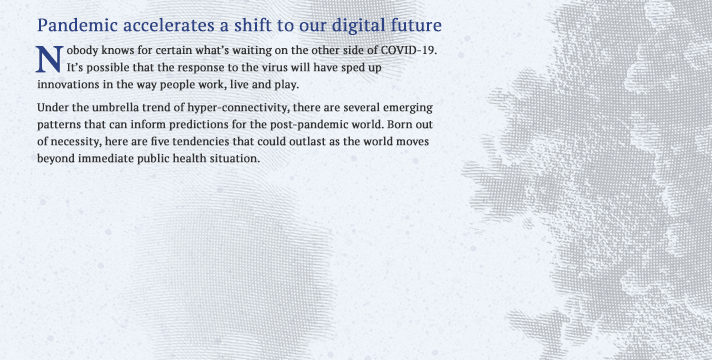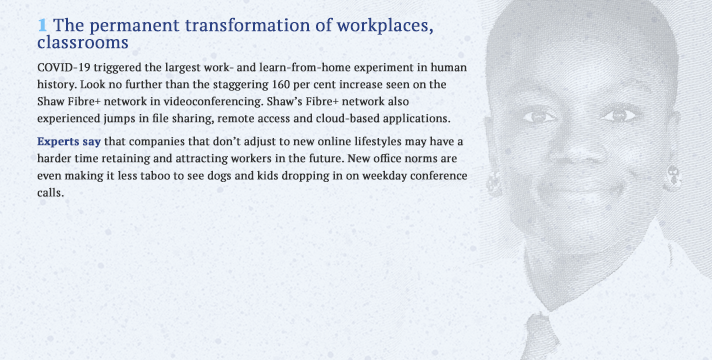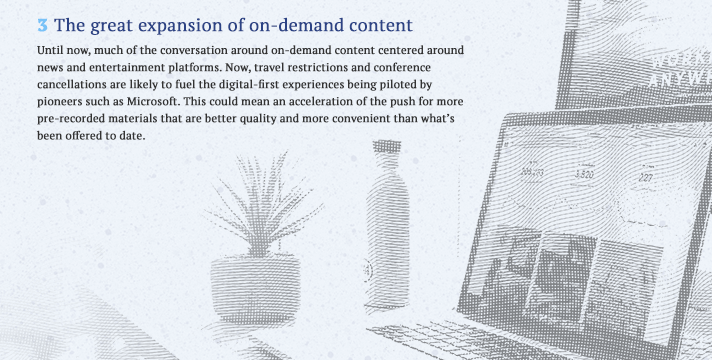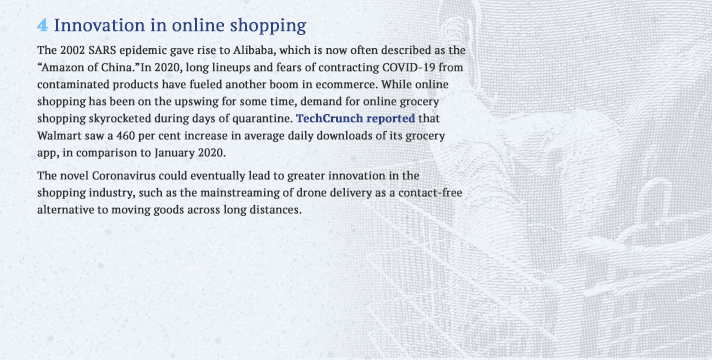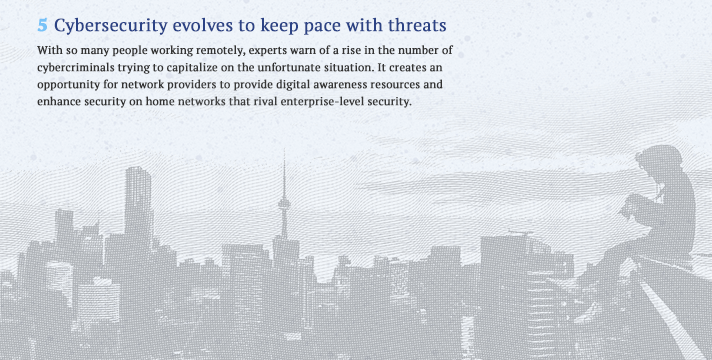Shaw’s Fibre+ network has passed the initial novel coronavirus stress-test, but the challenge of keeping Canadians connected didn’t begin or end with a worldwide pandemic. The confluence of new homebound routines and data-intensive tech only sped up our move toward a tech-forward future. In a world that runs on connectivity, Shaw and other network builders are putting Canada in a strong position to keep pace with the insatiable demand for bandwidth.
On the same day that the World Health Organization (WHO) declared COVID-19 a global pandemic, engineers at Calgary-based Shaw Communications were watching a precipitous spike in network traffic.
Listen to the new podcast “Bandwidth”, which digs further into the importance of connectivity
Residential internet use had already started to climb at a steady clip in early March, with many Western Canadians hunkering down in their homes due to the worsening viral outbreak. Then, on March 10, downstream traffic shot up by more than 18 percent in comparison to usual levels of activity on Shaw’s Fibre+ network—a spike four times larger than the major surge seen in November 2019 when Disney launched its Disney+ streaming service in Canada.
In this case, the exceptional one-day jump in network traffic wasn’t linked to increased teleworking or any of the pandemic’s knock-on effects. The cause of soaring network traffic stemmed from Activision’s March 10 release of Call of Duty: Warzone, a free-to-play video game that reportedly hit 6 million players worldwide in the first twenty-four hours after its launch.
Warzone—a sandbox, battle royale survival game—requires players who don’t already own the game to download a massive file in the range of eighty-three to 101 gigabytes (GB). To put this data into perspective, gamers would need to download the equivalent of more than thirty hours worth of high-definition Netflix videos before hitting the game’s start button.
Whether it’s the launch of a data-heavy video game, a crush of online shopping traffic over the holidays, or a major one-day national sporting event like the CFL’s Grey Cup, Shaw’s Fibre+ network was built to accommodate major swings in consumer demand.
Shaw’s resilient and future-proofed network was made possible by the more than $20 billion the company has invested in broadband infrastructure and services over the past seven years to build a network that is ready for growing customer demand and usage. Shaw’s Fibre+ network pushes fibre deep into the community and uses high capacity coax to connect nearby fibre nodes to individual homes, with fibre making up over 99% of the route traveled for each customer’s internet traffic.
“The sprint toward a hyper-connected world began long before COVID-19 impacted our daily lives. The effects of the health emergency only intensified existing trendlines, and it may now be the case that we’ve reached the tipping point for the digital transformation of our society,” says Damian Poltz, Shaw’s vice-president, technology strategy and network. “Thankfully, our Fibre+ network has proven to be highly resilient, with ample capacity to handle network traffic increases right now and well into the future.”
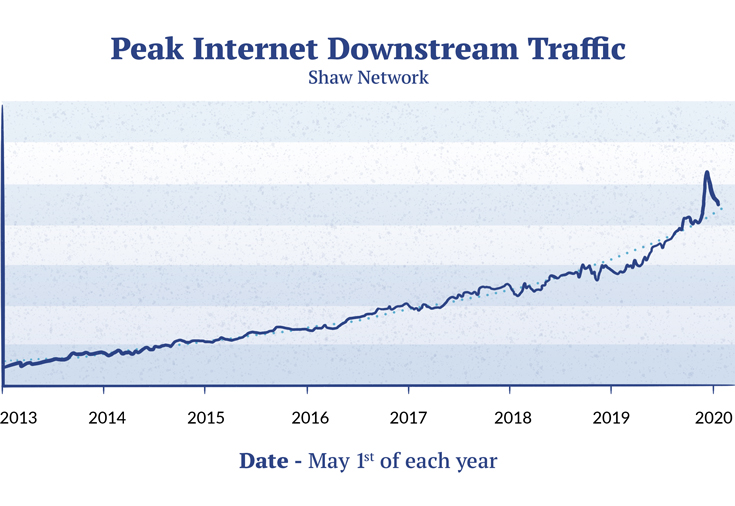
Unlike the economic fallout from the health crisis—which is acute and remains incalculable six months after the deadly virus emerged—internet consumption has predictably ticked upward for years. In fact, according to the Canadian Radio-television and Telecommunications Commission (CRTC), the amount of data downloaded and transmitted by home internet subscribers has soared each year over a five-year span.
To use the most recently published CRTC figures on high-speed households, the average amount of data downloaded by Canadian subscribers reached 192.9 GB per month in 2018, with 16.78 GB uploaded. These figures represent just over a 25-percent jump from the previous year’s high. The national data reflects the rise in the use of internet-connected devices at home, but it doesn’t account for COVID-19 turning in-home modems into lifelines to the outside world.
Since physical distancing measures were put in place across the country, internet usage on Shaw’s wireline network has increased by as much as 50 percent overall, and peak usage periods have climbed to twelve hours a day, every day of the week, instead of the usual three or four hours in the evening.
“Peak daily download traffic increased up to 26 percent above pre-COVID-19 levels on Shaw’s network in March,” Poltz says. “This sustained increase in traffic we saw in one week is what Shaw would typically see in a full year of network growth.
“It’s akin to one or two Call of Duty launches on Shaw’s network and downloading the equivalent of one or two Call of Duty games every single day for the entire month of March.”
Shaw’s network upload traffic also shot up 52 percent above normal levels, and created a never-before-seen twelve-hour peak traffic period, from 9 a.m. to 9 p.m. This incredible increase—nearly two years of network growth in ten days—was almost completely due to the rise in video conferencing and collaboration apps being used by Canadians working and schooling from home.
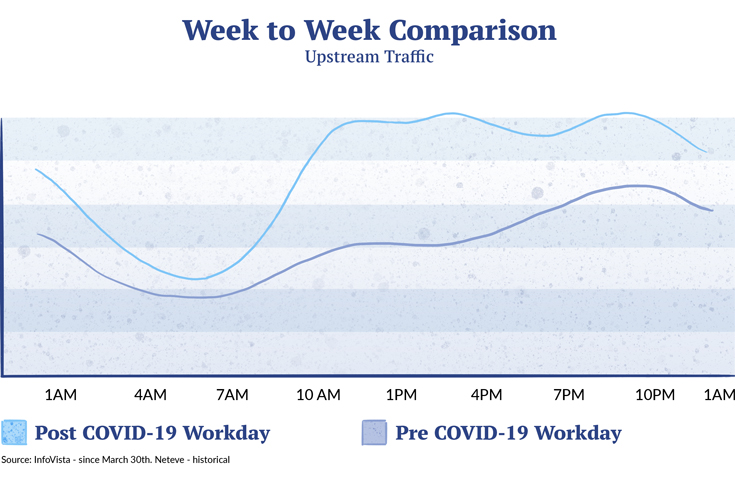
90%
of Canadian home internet customers said their home internet service handled the increased demand well during times of physical distancing.
7/10
Canadians reported using the internet more during the pandemic than before it.
1/5
Canadians said they upgraded their home internet services amid the public health emergency.
Source: Abacus Data (April 2020)
In most countries, streaming media was the number one source of downstream traffic before the COVID-19 pandemic hit—and that only grew as shut-in viewers increasingly turned to the small screen as a primary source of entertainment.
In response to the record demand, some of the biggest media companies in the world—including Amazon, Apple, Disney, and Facebook—voluntarily agreed to reduce the quality of their video content to help lighten the load placed on network operators in Europe. Netflix removed the highest bandwidth streams of its content in some countries and YouTube has lowered the default quality of videos to standard definition worldwide. The move was welcomed by some internet providers more than others: in hard-hit communities across Europe, India, and Israel, the ease on their networks was a much-needed relief.
By contrast, Shaw’s Fibre+ network was over 99 per cent congestion-free regardless of the time of day prior to the pandemic, with multiple levels of redundancy and plenty of room left in the pipe to survive a crisis. The company has invested time and resources into creating extra “head room” to accommodate whatever comes next.
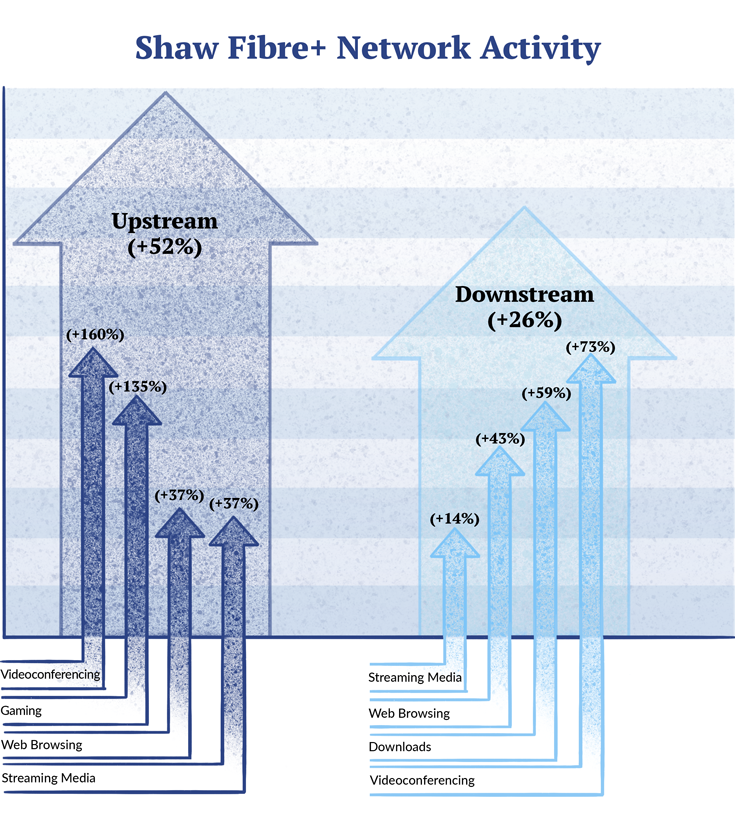
Shaw’s Fibre+ Network showcases its strength
Shaw was more than ready to meet the demand brought on by COVID-19 thanks to a series of innovative “mid-split” network upgrades that increased the capacity of its Fibre+ network. In all major markets, Shaw drove fibre to over 99 percent of the neighbourhoods it serves and beefed up network infrastructure—fibre nodes and amps—prior to the pandemic. This was all done without having to dig up customers’ lawns or swap out their modems (which other providers may need to do to provide a similar experience).
The mid-split upgrade, originally intended to bring multi-gigabit speeds to all customers across Shaw’s footprint, proved to be extremely timely; it has provided ample capacity to deal with the unprecedented levels of growth seen during the pandemic.
As a result, Shaw is able to provide over 99 percent of its customers with its fastest speeds, while leading North American cable operators in terms of broadband capacity. The Calgary-based company is committed to delivering the same experience to both its urban and rural customers. These upgrades also give Shaw the ability to deploy additional network capacity virtually overnight if needed, which is helpful in a world where broadband use is likely to increase.
“We’ve made smart architectural decisions when it comes to our network, and that’s paying off in a phenomenal way right now,” says Poltz. “The performance of our network is outstanding both globally in the cable industry and beyond—especially in terms of upload speeds.
“We’ve got a long runway on our current Fibre+ network and we still have technological options to increase capacity—even above current demand, if needed—through further hardware and software upgrades.”
In his Telecom Trends blog, independent consultant Mark Goldberg applauded network builders for investing in the creation of world-leading communications networks needed to weather massive shifts in consumer behaviour with only minimal disruptions to home services. Goldberg classified the industry’s response to the pandemic as nothing short of “heroic,” with the overnight adoption of physical distancing practices ramping up the country’s dependence on modern telecommunications services.
“The shelter-in-place orders really opened people’s eyes to how much they rely on high-speed connectivity. Every Zoom call, every on-demand video, every FaceTime chat was part of a massive shift in the way we interact with each other and the world around us,” he says. “I expect that we’re going to continue moving forward, not backwards, when we reflect on this crisis in the rearview mirror. It’s reasonable to expect we’ll continue to see a surge in new communications technologies spinning out of people’s redefined connected lives.”
#ShawHelps
In response to COVID-19, Shaw put the needs of Canadians first. To keep individuals, families, and communities connected and supported, Shaw launched a series of #ShawHelps initiatives.
This meant providing free access for everybody to Shaw Go WiFi — Canada’s largest WiFi network — at tens-of-thousands of hot spots across Western Canada. Shaw also provides complimentary data to Freedom Mobile customers most in need of data security, two months of free internet service to Shaw customers on the Government of Canada’s “Connecting Families” program.
Shaw also offered comprehensive, immersive digital educational programming for all Canadian children through a new strategic partnership with EVERFI—an international social impact education innovator. The company pledged $1 million to Community Food Centres Canada to support the efforts of community food centres and agencies in cities and towns across the country.
To realize the vast potential offered by 5G technology and allow Canadians to thrive in the digital economy, network builders must continue to invest in bolstering the speed and capacity of the broadband networks that undergird wireless infrastructure. Without continuous network investment, technological change will make today’s levels of broadband service the “dial-up” of the future. Success in the 5G era of connectivity requires the same type of forward-thinking approach, research, and investment that helped Canada withstand the onslaught of unprecedented wireline traffic during the pandemic.
“Shaw is at the forefront of the development of 5G networks,” Poltz says. “By combining the strength of our fixed wireline network with the reach of our growing wireless network, Shaw is well-positioned to bring the potential benefits of 5G technology to Western Canadians.
“We are working to bring the potential benefits of 5G to everything—from connected cities to smart homes, from next-gen products and services to innovations not yet conceived by entrepreneurs, academics, and researchers.”

